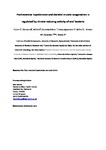Post-exercise hypotension and skeletal muscle oxygenation is regulated by nitrate-reducing activity of oral bacteria
| dc.contributor.author | Cutler, C | |
| dc.contributor.author | Kiernan, Michele | |
| dc.contributor.author | Willis, JR | |
| dc.contributor.author | Gallardo-Alfaro, L | |
| dc.contributor.author | Casas-Agustench, P | |
| dc.contributor.author | White, Desley | |
| dc.contributor.author | Hickson, Mary | |
| dc.contributor.author | Gabaldon, T | |
| dc.contributor.author | Bescos Garcia, Raul | |
| dc.date.accessioned | 2019-08-18T17:50:52Z | |
| dc.date.issued | 2019-11-01 | |
| dc.identifier.issn | 0891-5849 | |
| dc.identifier.issn | 1873-4596 | |
| dc.identifier.uri | http://hdl.handle.net/10026.1/14804 | |
| dc.description.abstract |
Post-exercise hypotension (PEH) is a common physiological phenomenon leading to lower blood pressure after acute exercise, but it is not fully understood how this intriguing response occurs. This study investigated whether the nitrate-reducing activity of oral bacteria is a key mechanism to trigger PEH. Following a randomized, double blind and crossover design, twenty-three healthy individuals (15 males/8 females) completed two treadmill trials at moderate intensity. After exercise, participants rinsed their mouth with antibacterial mouthwash to inhibit the activity of oral bacteria or a placebo mouthwash. Blood pressure was measured before, 1h and 2 h after exercise. The microvascular response to a reactive hyperaemia test, as well as blood and salivary samples were taken before and 2 h after exercise to analyse nitrate and nitrite concentrations and the oral microbiome. As expected, systolic blood pressure (SBP) was lower (1 h: -5.2 ± 1.0 mmHg; P < 0.001); 2 h: -3.8 ± 1.1 mmHg, P = 0.005) after exercise compared to baseline in the placebo condition. This was accompanied by an increase of circulatory nitrite 2 h after exercise (2h: 100 ± 13 nM) compared to baseline (59 ± 9 nM; P = 0.013). Additionally, an increase in the peak of the tissue oxygenation index (TOI) during the reactive hyperaemia response was observed after exercise (86.1 ± 0.6%) compared to baseline levels (84.8 ± 0.5%; P = 0.010) in the placebo condition. On the other hand, the SBP-lowering effect of exercise was attenuated by 61% at 1 h in the recovery period, and it was fully attenuated 2 h after exercise with antibacterial mouthwash. This was associated with a lack of changes in circulatory nitrite (P > 0.05), and impaired microvascular response (peak TOI baseline: 85.1 ± 3.1%; peak TOI post-exercise: 84.6 ± 3.2%; P > 0.05). Diversity of oral bacteria did not change after exercise in any treatment. These findings show that nitrite synthesis by oral commensal bacteria is a key mechanism to induce the vascular response to exercise over the first period of recovery thereby promoting lower blood pressure and greater muscle oxygenation. | |
| dc.format.extent | 252-259 | |
| dc.format.medium | Print-Electronic | |
| dc.language | en | |
| dc.language.iso | en | |
| dc.publisher | Elsevier | |
| dc.subject | Adult | |
| dc.subject | Bacteria | |
| dc.subject | Cross-Over Studies | |
| dc.subject | Double-Blind Method | |
| dc.subject | Exercise | |
| dc.subject | Female | |
| dc.subject | Humans | |
| dc.subject | Hyperemia | |
| dc.subject | Male | |
| dc.subject | Mouth | |
| dc.subject | Mouthwashes | |
| dc.subject | Muscle, Skeletal | |
| dc.subject | Nitrates | |
| dc.subject | Post-Exercise Hypotension | |
| dc.subject | Saliva | |
| dc.title | Post-exercise hypotension and skeletal muscle oxygenation is regulated by nitrate-reducing activity of oral bacteria | |
| dc.type | journal-article | |
| dc.type | Journal Article | |
| dc.type | Randomized Controlled Trial | |
| dc.type | Research Support, Non-U.S. Gov't | |
| plymouth.author-url | https://www.webofscience.com/api/gateway?GWVersion=2&SrcApp=PARTNER_APP&SrcAuth=LinksAMR&KeyUT=WOS:000496132900025&DestLinkType=FullRecord&DestApp=ALL_WOS&UsrCustomerID=11bb513d99f797142bcfeffcc58ea008 | |
| plymouth.volume | 143 | |
| plymouth.publication-status | Published | |
| plymouth.journal | Free Radical Biology and Medicine | |
| dc.identifier.doi | 10.1016/j.freeradbiomed.2019.07.035 | |
| plymouth.organisational-group | /Plymouth | |
| plymouth.organisational-group | /Plymouth/Faculty of Health | |
| plymouth.organisational-group | /Plymouth/Faculty of Health/School of Health Professions | |
| plymouth.organisational-group | /Plymouth/REF 2021 Researchers by UoA | |
| plymouth.organisational-group | /Plymouth/REF 2021 Researchers by UoA/UoA01 Clinical Medicine | |
| plymouth.organisational-group | /Plymouth/REF 2021 Researchers by UoA/UoA03 Allied Health Professions, Dentistry, Nursing and Pharmacy | |
| plymouth.organisational-group | /Plymouth/Research Groups | |
| plymouth.organisational-group | /Plymouth/Research Groups/Institute of Health and Community | |
| plymouth.organisational-group | /Plymouth/Research Groups/Institute of Translational and Stratified Medicine (ITSMED) | |
| plymouth.organisational-group | /Plymouth/Research Groups/Institute of Translational and Stratified Medicine (ITSMED)/CBR | |
| plymouth.organisational-group | /Plymouth/Research Groups/Plymouth Institute of Health and Care Research (PIHR) | |
| plymouth.organisational-group | /Plymouth/Users by role | |
| plymouth.organisational-group | /Plymouth/Users by role/Academics | |
| dc.publisher.place | United States | |
| dcterms.dateAccepted | 2019-07-28 | |
| dc.rights.embargodate | 2020-7-28 | |
| dc.identifier.eissn | 1873-4596 | |
| dc.rights.embargoperiod | Not known | |
| rioxxterms.version | Accepted Manuscript | |
| rioxxterms.versionofrecord | 10.1016/j.freeradbiomed.2019.07.035 | |
| rioxxterms.licenseref.uri | http://www.rioxx.net/licenses/all-rights-reserved | |
| rioxxterms.licenseref.startdate | 2019-11-01 | |
| rioxxterms.type | Journal Article/Review |


